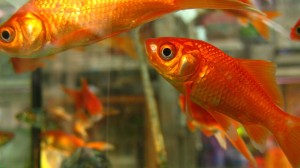 Einstein and the Goldfish Bowl
Einstein and the Goldfish Bowl
By Ellen Hetland Fenwick
I absorbed Einstein physics very well. I understood the changes. He made significant use of Riemann geometry, in which there are an infinite number of parallel lines through a given point. The geometry is part of the mother’s milk of mathematicians. The equations were relatively simple. I was comfortable and a believer.
There’s Always a String Attached
When string theory came along, I pondered for a while about whether it was worth the time to study it. Mostly it was theory with no data to verify its conjectures. And, of course, there were several string theories to choose from. I said, “Let’s wait until they agree and have some evidence to support the theory”. Meanwhile people adept at Physics are, I assume, staying intellectually and reasonably financially fit in some university teaching/research position until something more fruitful comes along.
Just When You Least Expect It
It seems to have happened. According to Wikipedia, “In theoretical physics, M-theory is an extension of string theory in which 11 dimensions of space-time are identified as seven higher-dimensions plus the four common dimensions (11D st = 7 hd + 4D). Proponents believe that the 11-dimensional theory unites all five 10 dimensional string theories and supersedes them.” Wikipedia further states that “… a full description of the theory is not known …”.

The “four common dimensions” are, of course, space-time: the three usual ones for space and the other one for time—Einstein’s model.
Maybe, But…
I have yet to look into M-theory. It is a child of string theory, and perhaps will prove fruitful. Meanwhile I muse on Plato’s Allegory of the Cave. He imagined human prisoners chained to a wall looking out at shadows produced by figures behind them that they cannot see. The figures hold up objects that produce these shadows. The prisoners are convinced that the shadows are reality. When one of the chained members escapes and visits the outside world, he then returns to tell his brethren about the real world. They cannot be convinced.
However, Who’s to Say?
Plato’s vision is not one that most of us would accept, but it makes a point, a point that is recapitulated in a new book by Stephen Hawking and Leonard Mlodinow.
“A few years ago the city council of Monza, Italy, barred pet owners from keeping goldfish in curved bowls. The measure’s sponsor explained the measure in part by saying that it is cruel to keep a fish in a bowl with curved sides because, gazing out, the fish would have a distorted view of reality. But how do we know we have the true, undistorted picture of reality?” We can’t.
Einstein Perspective
The goldfish view is not the same as our own, but goldfish could still formulate scientific laws governing the motion of the objects they observe outside their bowl. For example, due to the distortion, a freely moving object would be observed by the goldfish to move along a curved path. Nevertheless, the goldfish could formulate laws from their distorted frame of reference that would always hold true. Their laws would be more complicated than the laws in our frame, but simplicity is a matter of taste.”
We see, as the poet says, through a glass darkly. But we are in our own glass bowl or bowl of some sort. I truly believe that we will have to live with never knowing the true nature of the universe meanwhile building our models of what we think that immensity must be like.
Note: You might also enjoy The Neutron a Stable Particle?
References:
← Back to Math-Logic-Design
← Home

Love the goldfish bowl law! I wonder whether they don’t have something else to think about? I enjoyed reading the Plato work many years ago, very good. But the point about distorted reality is important. I seem to remember reading something quite a long time ago about the laws governing our “state” (as in states of being) not being capable of assessing something in a higher state, because the laws of the current state cannot be applied to higher states. It MIGHT be like trying to apply laws of fluid (water) to gases but not sure. Sorry, that’s probably not clear but it’s the closest I can now remember to what I read.